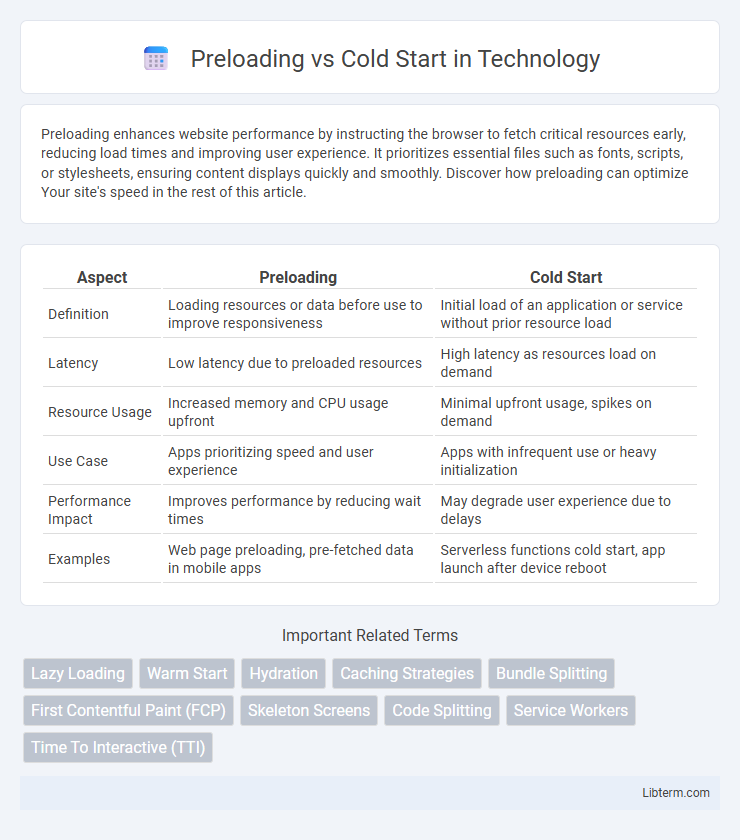Preloading enhances website performance by instructing the browser to fetch critical resources early, reducing load times and improving user experience. It prioritizes essential files such as fonts, scripts, or stylesheets, ensuring content displays quickly and smoothly. Discover how preloading can optimize Your site's speed in the rest of this article.
Table of Comparison
| Aspect | Preloading | Cold Start |
|---|---|---|
| Definition | Loading resources or data before use to improve responsiveness | Initial load of an application or service without prior resource load |
| Latency | Low latency due to preloaded resources | High latency as resources load on demand |
| Resource Usage | Increased memory and CPU usage upfront | Minimal upfront usage, spikes on demand |
| Use Case | Apps prioritizing speed and user experience | Apps with infrequent use or heavy initialization |
| Performance Impact | Improves performance by reducing wait times | May degrade user experience due to delays |
| Examples | Web page preloading, pre-fetched data in mobile apps | Serverless functions cold start, app launch after device reboot |
Introduction to Preloading and Cold Start
Preloading refers to the process of loading essential resources or data into memory before they are needed, significantly reducing latency and improving application responsiveness. Cold start occurs when a system or application initializes from a completely inactive state, often resulting in longer load times and delayed user interaction. Understanding the trade-offs between preloading and cold start is crucial for optimizing performance in web applications, serverless functions, and mobile apps.
Understanding Preloading: Definition and Benefits
Preloading involves loading resources or data into memory before they are needed, enabling faster access and reducing latency during application startup. This technique improves user experience by minimizing wait times and ensuring smoother performance, particularly in mobile apps and web services. Efficient preloading strategically allocates system resources to optimize responsiveness while avoiding excessive memory consumption.
What Is a Cold Start? Key Characteristics
A cold start occurs when a serverless function or application is invoked for the first time or after being idle, causing a delay as the environment initializes. Key characteristics include longer latency due to container or runtime provisioning, no cached data or preloaded dependencies, and a noticeable performance impact on user experience. This contrasts with preloading, where resources are prepared in advance to reduce initial startup time.
Performance Impact: Preloading vs Cold Start
Preloading improves application performance by loading essential resources proactively, reducing latency and minimizing the cold start delay experienced during initial execution. Cold start occurs when an application or function initializes without preloaded dependencies, causing slower response times and increased resource consumption. Optimizing performance involves balancing preloading strategies to minimize cold start impacts while managing memory and startup overhead effectively.
User Experience Comparison
Preloading significantly enhances user experience by reducing app launch time and minimizing delays, whereas cold start results in noticeable latency as the app initializes resources from scratch. Users perceive preloading as smoother and more responsive, maintaining engagement through instantaneous access to content. Cold start can lead to frustration due to longer wait times, especially on resource-intensive applications or slower devices.
Resource Utilization and Efficiency
Preloading improves resource utilization by initializing necessary components before demand peaks, reducing latency and smoothing workload distribution. Cold start, by contrast, causes inefficient resource use as systems allocate resources under sudden demand, leading to higher response times and potential bottlenecks. Optimizing preloading strategies enhances overall efficiency by balancing resource allocation and minimizing idle periods during low traffic.
Common Use Cases for Preloading
Preloading is commonly used in web applications and mobile apps to improve user experience by loading essential resources or data before user interaction begins, reducing latency during navigation. It is particularly effective in scenarios like image-heavy websites, single-page applications, and streaming services where anticipating user needs enhances performance. By contrast, cold start issues often arise in serverless or cloud environments where functions or containers are initialized on demand, causing delays without prior preloading strategies.
Addressing Cold Start Challenges
Preloading techniques reduce cold start latency by initializing resources and dependencies before user requests, significantly improving application responsiveness in serverless and microservices environments. Cold start challenges arise when functions or containers spin up from zero capacity, causing delays that degrade user experience and system performance. Optimizing resource allocation, employing provisioned concurrency, and leveraging caching strategies effectively mitigate cold start issues and enhance real-time processing efficiency.
Best Practices for Managing App Startup
Preloading essential resources and optimizing cold start processes are critical best practices for improving app startup performance. Implementing lazy loading, splitting code bundles, and caching frequently used assets reduce startup latency and enhance user experience. Monitoring launch times and leveraging platform-specific APIs for background resource initialization further ensures seamless app readiness.
Future Trends in Application Initialization
Future trends in application initialization emphasize reducing cold start latency through advanced preloading techniques leveraging AI-driven predictive models to anticipate user behavior. Container orchestration platforms and serverless architectures are evolving to support dynamic resource provisioning, enabling seamless warm starts and minimizing startup delays. Edge computing integration further accelerates app readiness by distributing preloaded instances closer to end-users, enhancing responsiveness and user experience.
Preloading Infographic

 libterm.com
libterm.com